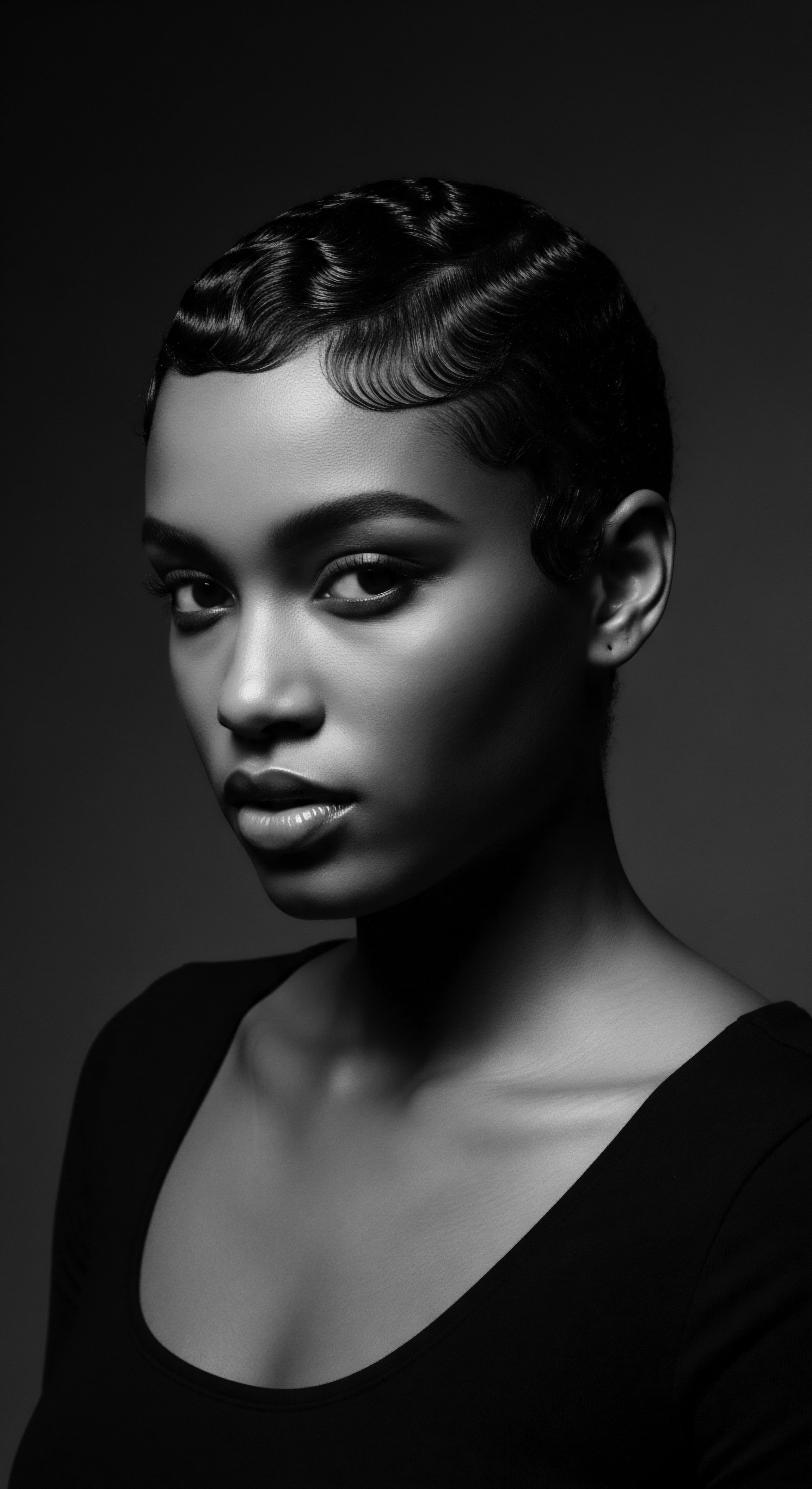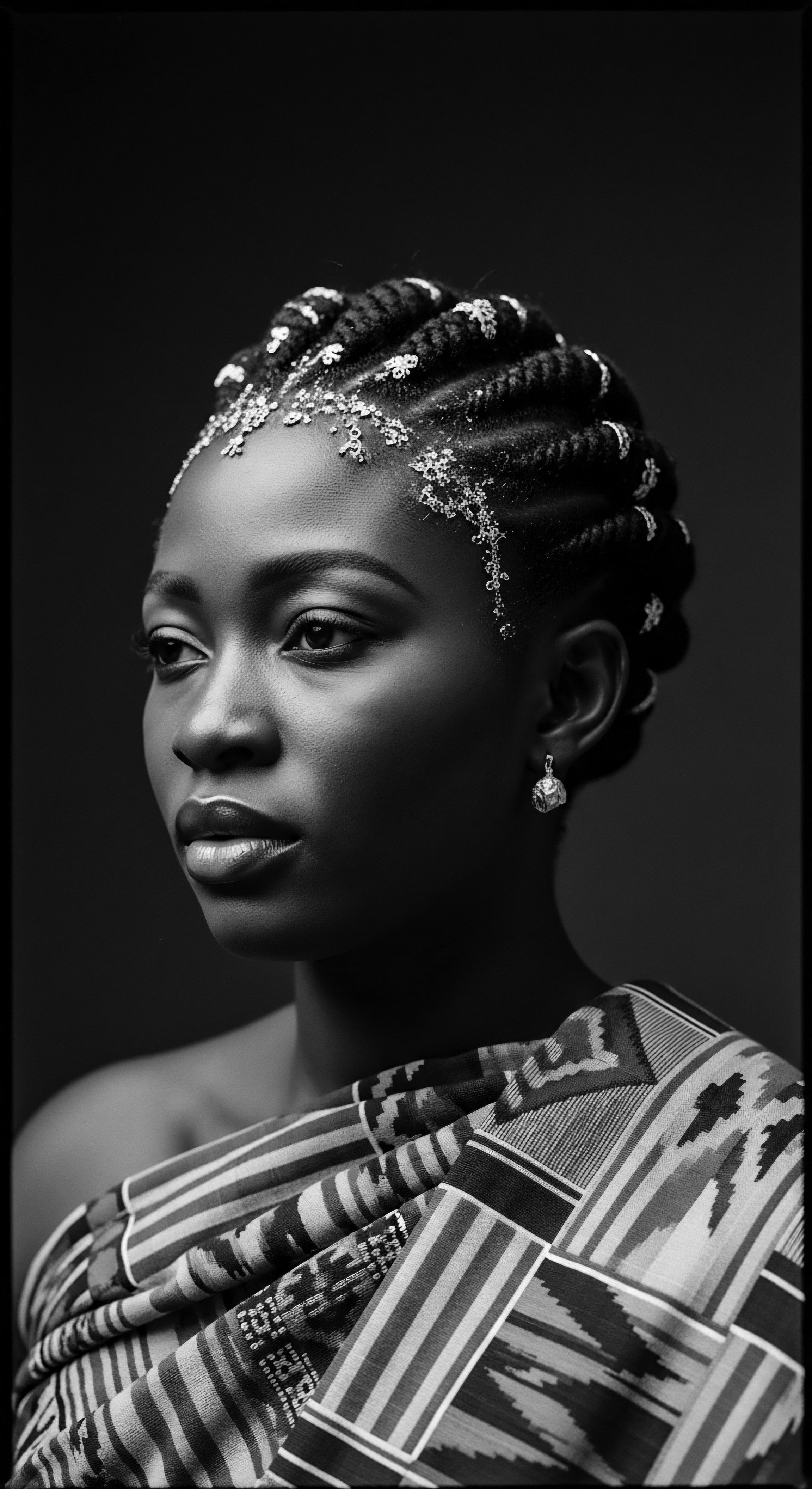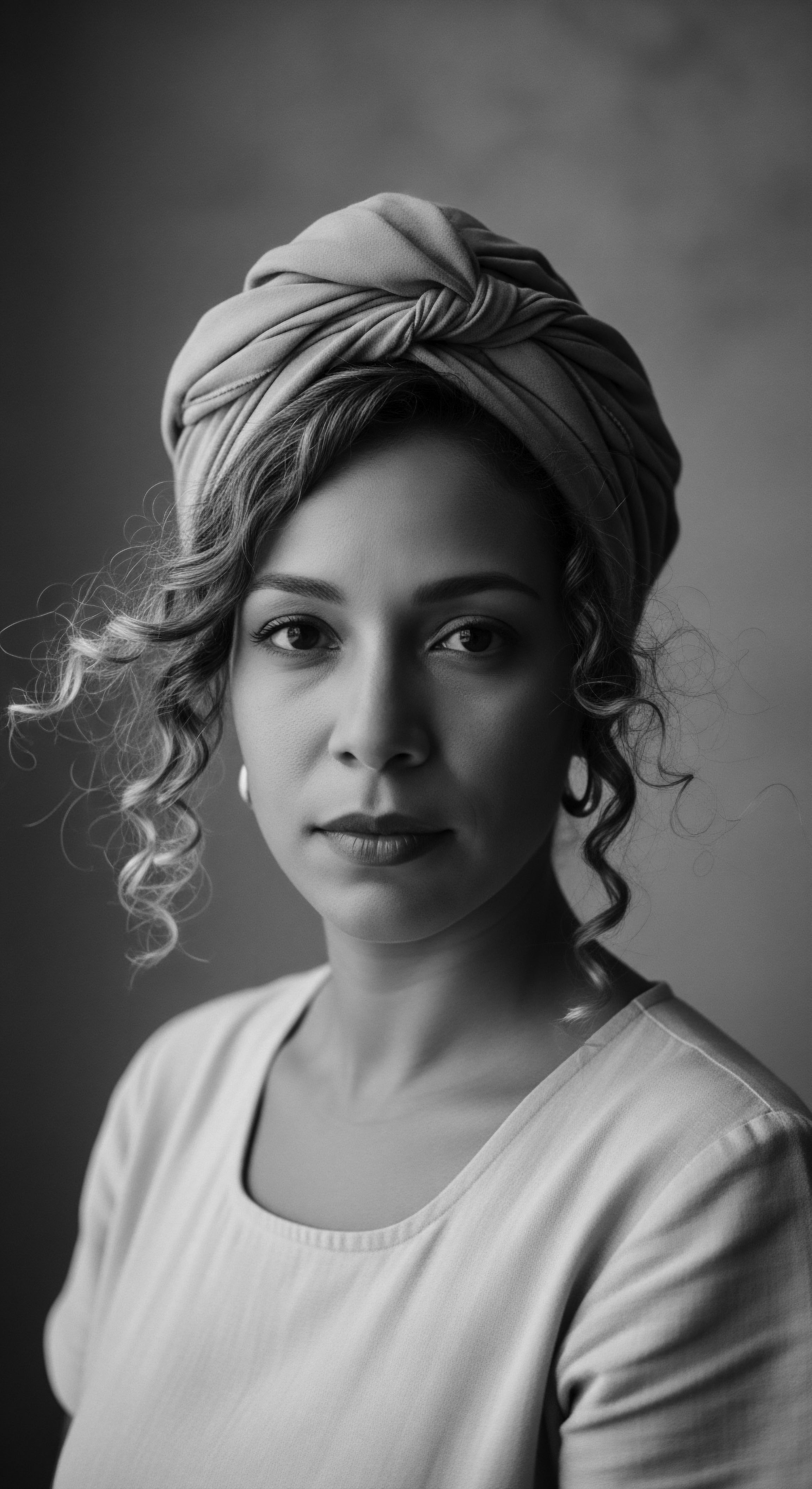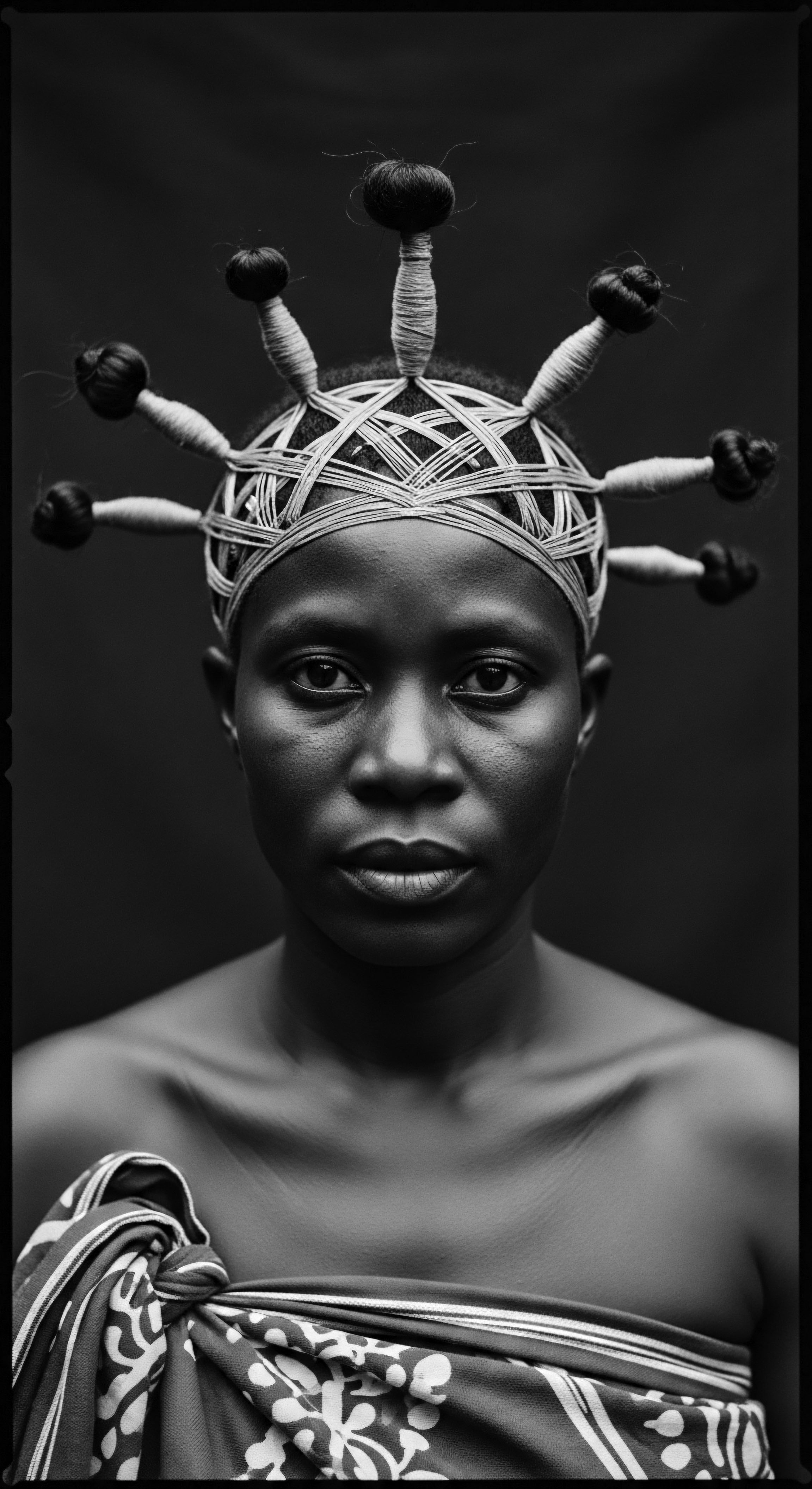
Fundamentals
The Head Wrap, at its simplest, identifies a piece of cloth, often rectangular or square, meticulously fashioned around the head to cover or adorn the hair. This elemental definition belies the intricate layers of significance and practical applications embedded within its form. While appearing as a straightforward garment, its function extends beyond mere aesthetic or casual use. Across diverse cultures, particularly those with deep connections to textured hair traditions, the head wrap serves to safeguard the hair from environmental elements such as sun, wind, and dust, preserving its inherent moisture and protecting delicate strands from external stressors.
Consider its role in preserving hairstyles; the head wrap holds coily and curly textures in place, minimizing manipulation and thereby reducing breakage. This physical shielding also acts as a barrier against friction, particularly when constructed from smooth materials like silk or satin, which are gentle on the hair’s cuticle, preventing tangles and preserving the integrity of protective styles.
A head wrap is a piece of fabric artfully styled around the head, offering both hair protection and profound cultural meaning across generations.

Cultural Underpinnings and Early Forms
Originating in Sub-Saharan Africa as early as the 1700s, the head wrap, known by various names such as Gele in Nigeria, Duku in Ghana, or Doek in South Africa, rapidly gained prominence, even becoming a recognized accessory among Nubian queens in ancient Egypt. Hieroglyphic evidence points to ancient pharaohs who utilized headbands or covered their hair with wigs, and divine crowns for royalty often featured cloth with specific meanings. The early forms of head wraps were not simply about covering hair; they communicated a woman’s cultural identity and family practices, marking social status, marital standing, and even religious affiliations.
In many traditional African societies, the manner in which a head wrap was tied, its colors, and patterns could convey rich information about the wearer. For example, in some communities, tying a fabric on the right side might signal marital status, while a tie on the left could suggest an unmarried individual. The practice of wearing head coverings during sleep to maintain hairstyles and prevent dryness from cotton pillowcases is also a long-standing tradition. Rural women historically wore head wraps as protective clothing to shield their hair from dust and dirt during daily chores.

Intermediate
Beyond the immediate utility of hair protection, the head wrap carries a deeply woven significance, functioning as a powerful symbol of heritage, identity, and resilience, particularly within Black and mixed-race communities. Its meaning extends far beyond simple adornment, serving as a visual statement, a historical marker, and a conduit for ancestral wisdom. The head wrap’s symbolic meaning is deeply tied to its historical journey, particularly through the transatlantic slave trade and subsequent diaspora.
When Africans were forcibly removed from their homelands and transported to the Americas, they carried with them the traditions of hair wrapping. Initially, during the era of enslavement, head coverings were often imposed as a means of control and dehumanization, intended to hide hair deemed “unsightly” or “unkempt” by enslavers, reducing the enslaved to a lesser social status. Yet, through a profound act of defiance and creative spirit, Black women transformed these symbols of oppression into vibrant expressions of cultural pride and individual identity.
The head wrap embodies a story of cultural continuity and resilience, a testament to enduring beauty and resistance in the face of historical challenges.

The Tignon Laws ❉ A Case Study in Resistance
A poignant historical instance that powerfully illuminates the head wrap’s connection to textured hair heritage and Black hair experiences is the enactment of the Tignon Laws in colonial Louisiana. In 1786, Spanish Governor Esteban Rodríguez Miró issued a decree, the “bando de buen gobierno,” which mandated that women of color, whether free or enslaved, wear a headscarf, known as a Tignon, in public. This law was a deliberate attempt to enforce modesty, reinforce social hierarchies, and visually distinguish women of African descent from white women. It also aimed to curb the perceived “extravagance” of free Black women whose elaborate hairstyles were attracting the attention of white men, challenging the prevailing social order.
The intent was clear ❉ to suppress Black women’s beauty and assert their subordinate status. However, these women, with their boundless ingenuity, transformed the tignon into a powerful form of cultural resistance. Instead of succumbing to the intended degradation, they crafted their mandated head coverings from luxurious fabrics, adorned them with jewels, ribbons, and feathers, and styled them with remarkable artistry. The tignon, meant to be a mark of inferiority, became a striking declaration of their beauty, wealth, and creative spirit, serving as a subtle yet potent act of rebellion.
This historical example underscores how a tool of oppression was reclaimed and reimagined, allowing Black women to assert their dignity and cultural continuity. The Tignon Laws may have eventually faded with the Louisiana Purchase in 1803, but the legacy of defiant self-expression through head wraps persisted, becoming a cornerstone of Black hair heritage.
| Intention of the Law To mark free Black women as visually inferior and suppress their perceived extravagance by requiring tignons. |
| Black Women's Response Women utilized luxurious fabrics, intricate tying techniques, and added embellishments like jewels and feathers. |
| Enduring Heritage Significance The tignon became a symbol of defiance, beauty, and cultural identity, enduring beyond the law's enforcement. |
| Intention of the Law To distinguish women of African descent from white women and enforce social hierarchy. |
| Black Women's Response The head wraps transformed into striking fashion statements, showcasing creativity and resilience. |
| Enduring Heritage Significance This creative rebellion affirmed self-expression and established a legacy of hair as a site of resistance. |
| Intention of the Law The transformation of the tignon reflects the profound ability of Black women to reclaim power and express identity through hair traditions, regardless of adversity. |

Protective Qualities and Wellness Connections
From a practical standpoint, the head wrap continues to serve as an indispensable tool for textured hair care, particularly for Afro-textured hair, which often possesses a tightly coiled structure and can be prone to dryness and breakage. The deliberate act of wrapping the hair minimizes daily manipulation, a key factor in reducing damage and promoting length retention. It creates a physical barrier that shields delicate strands from environmental stressors such as harsh sun, drying winds, and pollutants.
Moreover, head wraps play a vital role in moisture retention. When paired with moisturizing products, the fabric helps to seal in hydration, which is especially important for hair types with fewer protective cuticle layers that may not lie completely flat, making them more susceptible to moisture loss. This function aligns with ancestral wisdom regarding hair care, where practices often focused on nourishing and preserving the hair’s natural state.
The connection to wellness extends beyond the physical. Many traditional practices of hair oiling, for instance, were complemented by covering the hair. After a gentle massage with warmed oils, wrapping the hair with a hot towel or head covering helps to open the hair cuticles, allowing the oils to penetrate deeper into the scalp and strands. This practice not only enhances the physical benefits of the oils but also often carries a meditative quality, fostering relaxation and a sense of self-care rooted in ancient rituals.

Academic
The Head Wrap, as a cultural artifact and sociolinguistic marker, signifies a complex interplay of historical forces, biological imperatives, and diasporic aesthetic expressions. Its definition transcends a mere descriptive explanation of a cloth garment covering the head; it constitutes a profound statement on identity, belonging, and resistance within populations of African and mixed-race descent globally. This elucidation positions the head wrap not merely as an accessory, but as a dynamic textual representation of embodied heritage, a non-verbal lexicon transmitting social, spiritual, and political meanings across generations. Its meaning is rooted in the continuous negotiation between imposed narratives and self-determined modes of expression, particularly concerning textured hair.
From an anthropological perspective, the head wrap’s historical trajectory illustrates a remarkable example of cultural syncretism and adaptive survival. Its pre-colonial African origins point to a diverse range of functions ❉ conveying social status, marital state, tribal affiliation, and spiritual devotion. These traditional designations were embedded within community structures, where the intricate styling and material of the head covering communicated a nuanced social grammar.
For instance, in West Africa, the Gele, an elaborate head wrap of the Yoruba and Igbo people, served as an indicator of status, with greater intricacy denoting higher social standing. Such practices reveal a sophisticated system of visual communication through sartorial choices, where hair, as a central component of self-presentation, was inextricably linked to collective identity.
The head wrap is a profound cultural text, meticulously woven from historical struggle and persistent self-determination, speaking volumes about identity and ancestral ties.
The forced migration during the transatlantic slave trade profoundly reconfigured the head wrap’s symbolic load. Initially, the imposition of head coverings upon enslaved African women aimed to strip them of their cultural markers and dignity, erasing the elaborate hairstyles that once symbolized pride and identity. Yet, in a powerful act of agency and creative reclamation, these coverings were transformed. The Tignon Laws in 18th-century Louisiana stand as a seminal example.
Mandated by Spanish Governor Miró in 1786, these laws required free Black women, whose elaborate hairstyles were perceived as a challenge to the racial hierarchy, to wear head coverings. The intention was to visually relegate them to the status of enslaved persons and to diminish their perceived attractiveness to white men. However, the ingenuity of these women converted an instrument of subjugation into a vivid declaration of identity. They employed expensive fabrics, vibrant colors, and sophisticated tying methods, effectively subverting the law’s intent.
This historical act of resistance cemented the head wrap as a symbol of defiance and an enduring marker of Black women’s autonomy and cultural resilience in the diaspora. The head wrap, therefore, functions as a living archive of colonial resistance and post-colonial self-assertion.

Biological and Biophysical Dimensions
From a biological and biophysical standpoint, the head wrap offers tangible benefits for the preservation and health of textured hair, particularly Afro-Textured Hair. This hair type is characterized by its helical structure, which results in multiple points of curvature along the hair shaft. This inherent characteristic makes it susceptible to dryness, as natural scalp oils struggle to travel from the scalp to the ends of the hair, and prone to breakage due to mechanical stress at these points of curvature.
- Moisture Retention ❉ The head wrap acts as a physical barrier, significantly reducing the evaporation of moisture from the hair strands. When worn over moisturized hair, especially after applying leave-in conditioners or natural oils, it creates a microclimate that helps to seal in hydration. This is particularly valuable for textured hair, which tends to be more porous and loses moisture more readily.
- Reduced Mechanical Stress ❉ Daily manipulation, such as combing, brushing, and styling, can cause considerable breakage for textured hair. By covering the hair, the head wrap minimizes the need for frequent manipulation, giving the hair a respite from external forces. This preservation of undisturbed hair reduces friction and tangling, promoting length retention over time.
- Environmental Protection ❉ The head wrap shields the hair from environmental aggressors. Direct exposure to sunlight can degrade hair proteins, leading to dryness and brittleness. Wind can cause tangles and further moisture loss, while dust and pollutants can accumulate on the hair, necessitating more frequent washing. A head wrap provides a protective layer against these elements, maintaining the hair’s integrity.
- Friction Prevention ❉ When fashioned from smooth materials like silk or satin, head wraps mitigate friction against abrasive surfaces such as cotton pillowcases. This reduced friction is crucial for preventing breakage, preserving curl patterns, and minimizing frizz, thereby extending the life of hairstyles and promoting overall hair health.
Dr. Samantha Lee, a trichologist specializing in hair health, observes, “When done correctly, protective styles like wraps and braids can significantly improve hair health over time by reducing stress on the hair shaft and promoting natural oil distribution.” This scientific validation echoes the practical wisdom of ancestral practices, where hair coverings were an intuitive response to the biological needs of textured hair long before modern trichology emerged. The synergy between traditional care and contemporary understanding emphasizes the head wrap’s multifaceted contribution to hair wellness.

Psycho-Sociological and Spiritual Interpretations
The head wrap’s meaning extends into the profound realms of psycho-sociology and spirituality. As a visible marker, it shapes self-perception and external reception. The act of choosing to wear a head wrap, particularly in contemporary Western societies where natural Black hair has historically faced discrimination, represents a powerful affirmation of racial identity and a rejection of Eurocentric beauty standards. The CROWN Act in the United States, for instance, which makes discrimination based on natural hair textures illegal in workplaces and schools, underscores the ongoing societal policing of Black hair and the continuous need for such affirmations.
- Symbol of Resistance ❉ The head wrap emerged as a symbol of resistance during periods of oppression, particularly in the Americas. In the Civil Rights Movement and the Black Power movement, it reappeared as a potent symbol of Black pride, political consciousness, and a reconnection to African roots. Angela Davis, Erykah Badu, and other figures have utilized head wraps as statements of empowerment, beauty, and defiance.
- Spiritual and Energetic Significance ❉ Many cultural and spiritual traditions recognize the head as a sacred space, often associated with the crown chakra—a gateway to higher consciousness and spiritual connection. Wearing a head wrap can symbolize reverence, modesty, or devotion. It is believed to act as a shield, guarding against negative energies or harmful influences, thereby maintaining spiritual balance and protection. The intentional act of covering the head can also serve as a meditative practice, fostering focus and inner peace.
- Community and Lineage ❉ The head wrap serves as a tangible link to ancestral practices and a unifying element within the African diaspora. It connects individuals to a shared lineage, celebrating diverse cultural artistry and historical resilience. This connection to heritage can be a source of profound grounding and belonging, fostering a sense of continuity from ancient traditions to modern self-expression.
The head wrap thus stands as a testament to the power of adornment to transcend mere aesthetics, serving as a complex signifier within a broad socio-cultural narrative of self-determination and reverence for ancestral knowledge. Its enduring presence and varied interpretations speak to its deep, adaptive, and ever-relevant meaning for those who wear it.

Reflection on the Heritage of Head Wrap
The head wrap, in its myriad forms and expressions, reflects an enduring legacy woven into the very fiber of textured hair heritage. Its journey, from the elemental biology of hair protection to the profound cultural statements it conveys, mirrors the resilience of Black and mixed-race communities across time and geography. The ancestral wisdom embedded in its use—preserving moisture, minimizing manipulation, shielding from the elements—speaks to an innate understanding of natural hair’s needs, passed down through generations long before scientific validation.
This journey is not a linear progression from past to present but a continuous, living dialogue. The head wrap continues to voice identity, shaping futures by connecting wearers to a lineage of strength, creativity, and self-possession. It stands as a testament to how practical necessity became a canvas for artistic expression, how enforced uniform transformed into defiant beauty, and how an inherited practice remains a vibrant part of contemporary wellness and cultural pride.
Each knot, each fold, each color choice tells a story, affirming the unbreakable spirit of a people and the timeless beauty of their hair. The head wrap, ultimately, is a declaration of heritage, a whisper of ancient knowledge, and a vibrant crown for the unbound helix of textured hair.

References
- Byrd, A. D. & Tharps, L. L. (2014). Hair Story ❉ Untangling the Roots of Black Hair in America. St. Martin’s Press.
- Dove, D. & Powers, W. (2018). Hair and Identity ❉ A Qualitative Study of African American Women. Journal of Black Studies.
- Gould, V. M. (1996). Chained to the Rock of Adversity ❉ Free Black Women in New Orleans, 1786-1862. The University of Georgia Press.
- Johnson, K. A. & Bankhead, A. (2014). The Hair Story ❉ Untangling the Roots of Black Hair in America. St. Martin’s Press.
- Mercer, K. (1994). Welcome to the Jungle ❉ New Positions in Cultural Studies. Routledge.
- Thompson, E. (2009). The Black Civil Rights Movement. Greenwood Press.
- Yerima, T. (2017). Imperial Aesthetic ❉ Hair and Identity in Postcolonial Africa. Cultural Studies Review.
